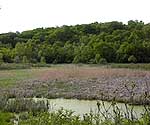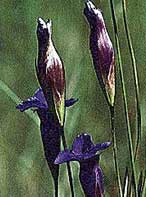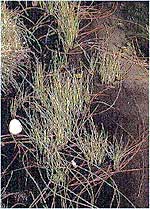By Dan Olson
Minnesota Public Radio
October 7, 2002
We've nearly paved over paradise in the Twin Cities with parking lots, homesites, roads and shopping centers. Less than 6 percent of the seven-county region's original habitat remains. Remnants are all that's left of the prairie, big woods, streams and other natural systems the first residents saw. There's a drive on to protect what remains.
| |
|
|
|
||
Hannah Dunevitz squishes through Seminary Fen in Chanhassen and stops to bounce on nature's trampoline.
"You can feel a lot of bounce here," Dunevitz says. "And that's because we're on deep peat. That peat has formed over hundreds, maybe thousands, of years in this very cold water, high mineral environment."
Dunevitz, a Minnesota Department of Natural Resources ecologist, says there are only a few hundred fens on the planet - places where water high in bicarbonates bubbles to the surface, supporting dozens of unusual plant species - the large flowered lobelia, beaked spike rush, red-ozier dogwood and marsh marigold. And then there's the resplendent fringed gentian.
"It's bright purple. It does have petals that are fringed. Gentians are some of the prettiest plants you'll see in wetlands in the fall," Dunevitz says.
Dunevitz and others want to preserve Seminary Fen, a 600-acre swatch of land that drops down from bluffs along the Minnesota River valley in Chanhassen and neighboring Chaska.
| |
|
|
|
||
Among other attractions, the fen contains Carver County's last trout stream and a naturally reproducing population of native brook trout.
Unlike the clear, cold calcium and magnesium-laced water burbling up through its peat, Seminary Fen's future is murky. The land is privately owned, and unprotected. One of the owners, a retired farmer, is agreeable to holding off development on the portion he controls.
A land speculation company owns the rest and is interested in selling pieces to developers. However, the owners are also cooperating with efforts to save the fen's most biologically important features.
The DNR's Sharon Pfeifer has helped identify about 225,000 acres of high-quality Twin Cities habitat that hasn't been paved, plowed or drained.
"Portions of that, about 73,000 acres, are high quality. But they are unprotected at this time, by park status or any other protected status," Pfeifer says.
Seventy-thousand acres is a lot of land, more than twice the size of Minnesota's largest state park, St. Croix State Park.
| |
|
|
|
||
But it's postage-stamp small when compared to the three million acres that comprise the seven-county Twin Cities area. And the parcels are often like islands, wild areas bounded by roads and development.
Preserving them is gaining momentum. The McKnight Foundation, one of Minnesota's largest foundations, has an Embrace Open Space campaign to save what it calls 10 Twin Cities treasures. Among them are Bassett's Creek and Crow River in Hennepin County, and Lower Phalen Creek in Ramsey County.
Dakota county's Vermillion River Bottoms is targeted by McKnight, the DNR and local residents. Dakota is one of the state's fastest-growing counties. DNR officials say only 2 percent of it's natural habitat remains.
On election day this November, Dakota county residents will vote on a ballot question, asking if they want to pay about $2 more in taxes per month to preserve the county's remaining habitat. Rick Hansen, a proponent of the measure, says they want to raise as much as $20 million.
| |
|
|
|
||
"Dakota County has a rich agricultural history, a lot of diversity - truck farms, crop farms - and the same is true of the scenic and natural areas," says Hansen. "We've got the Minnesota River on one side, the Mississippi on the other and the largest undeveloped watershed in the Twin Cities, the Vermillion watershed."
Two years ago, voters in Washington County voted down a similar idea. However residents of several cities - Eden Prairie, Lake Elmo and St. Michael, among them, voted to preserve habitat.
Residents of St. Michael, a northwestern Twin Cities community, voted to buy a 28-acre remnant of the Big Woods, a hardwood forest that once blanketed eastern Minnesota. City administrator Bob Derus says residents voted to pay about $50 a year more in property taxes over five years on an average value home, to keep the remnant a natural and scenic area.
"It's directly across the street from our middle school. So the science teachers and some of the art teachers and a number of the residents got excited about the classroom possibilities of that," Derus says.
The Metropolitan Council also supports Twin Cities habitat preservation, and is intent on finding money to support it. However, all the council members are essentially lame ducks. They're appointed by the governor, and come November there'll be a new governor and a new Legislature - whose members will almost certainly have their own ideas about the value of habitat preservation.
More from MPRMore Information




